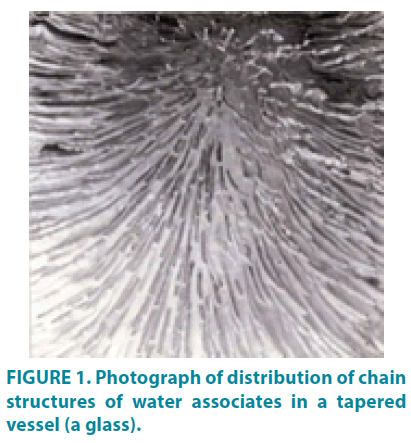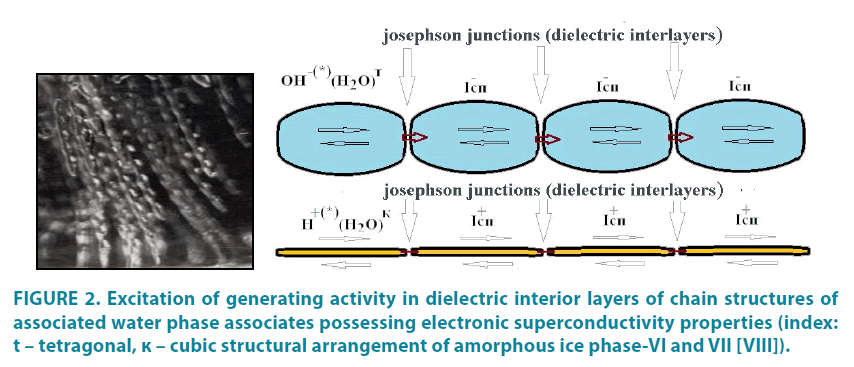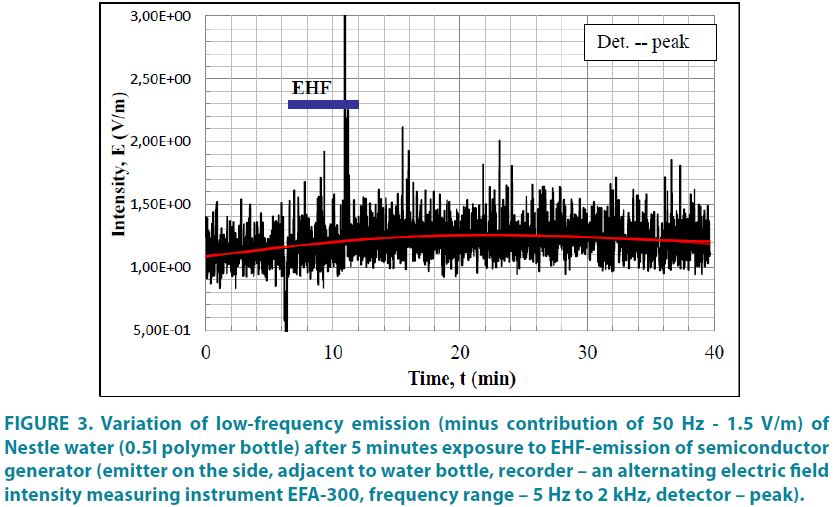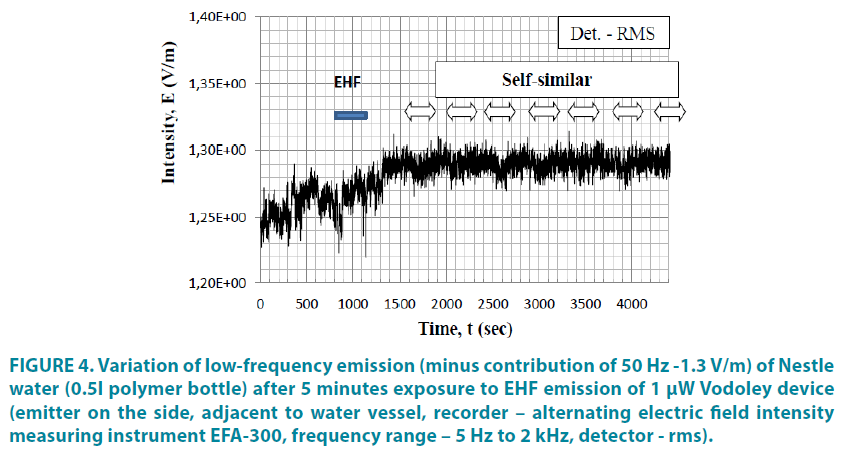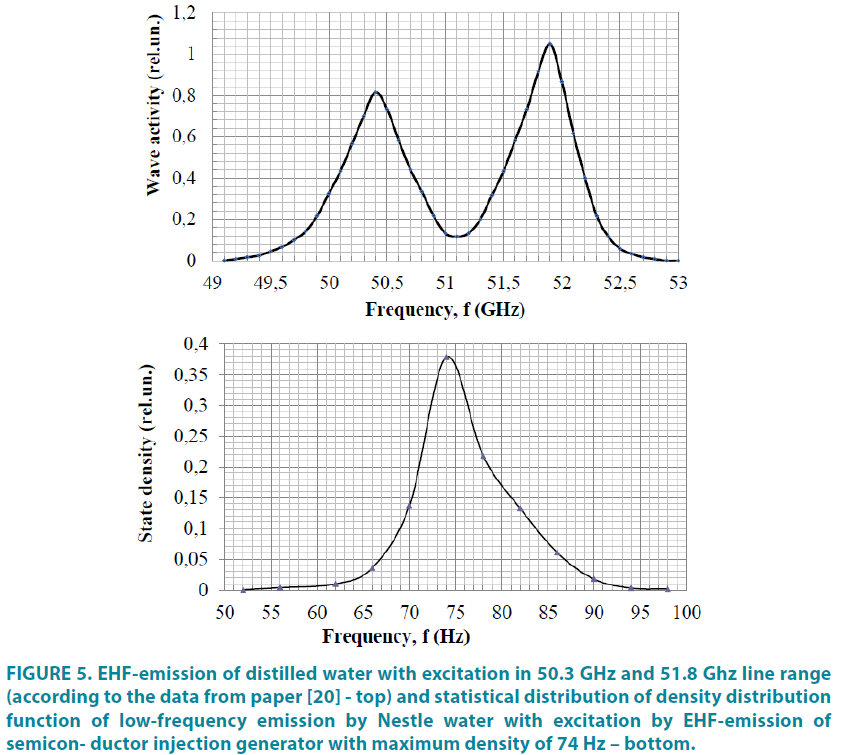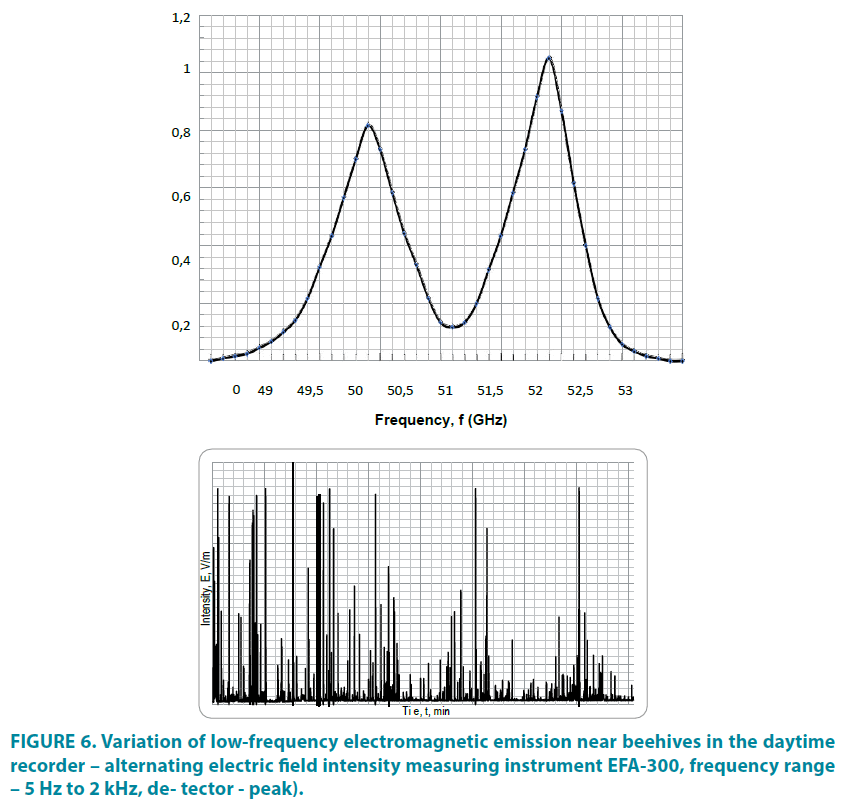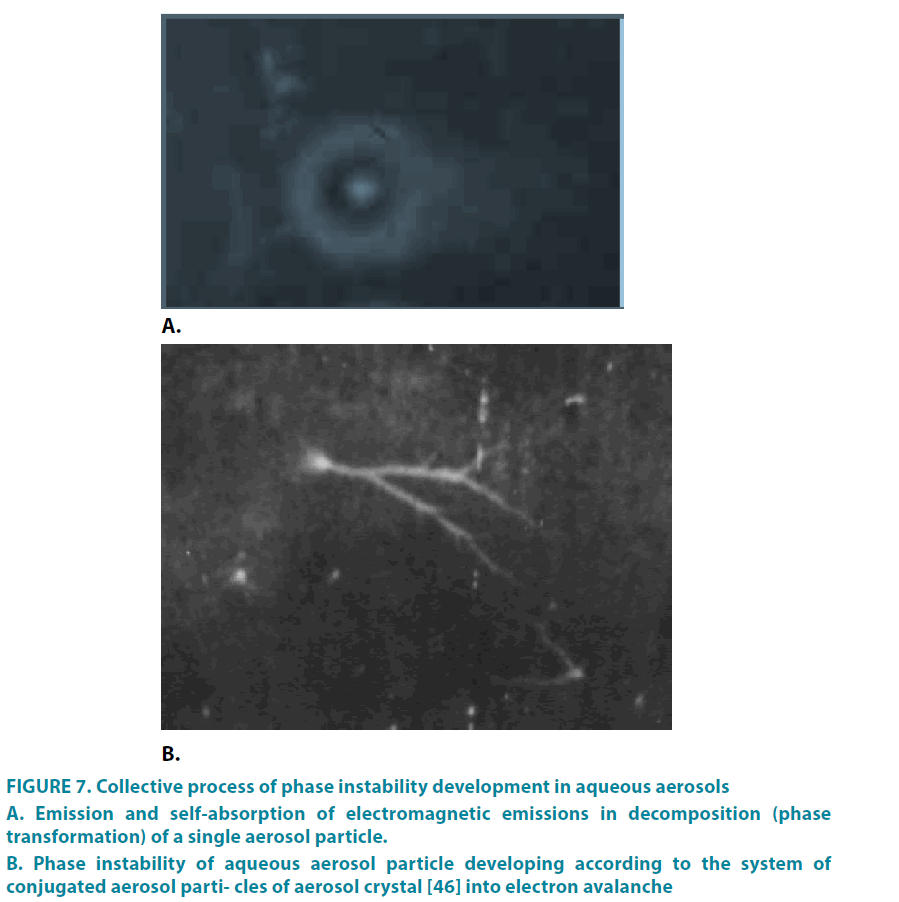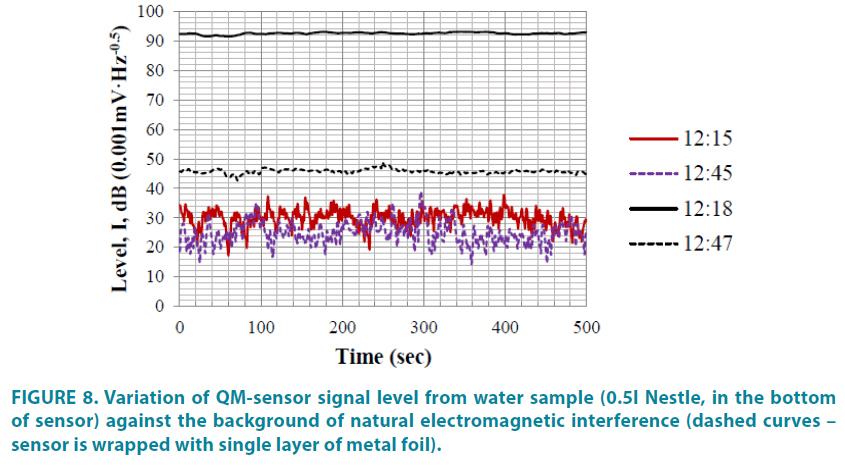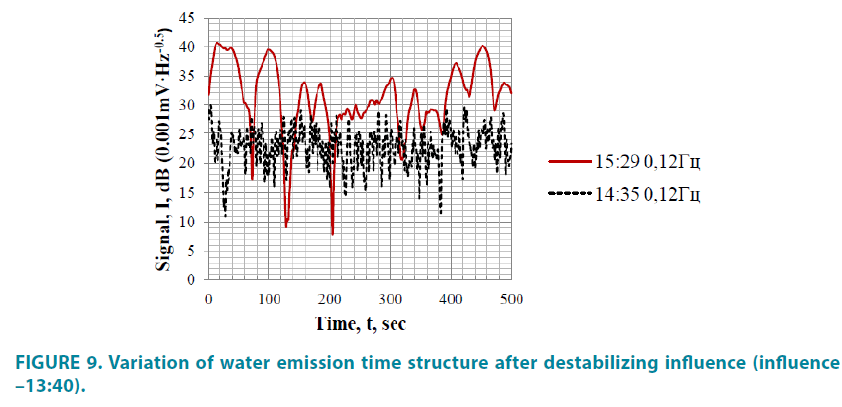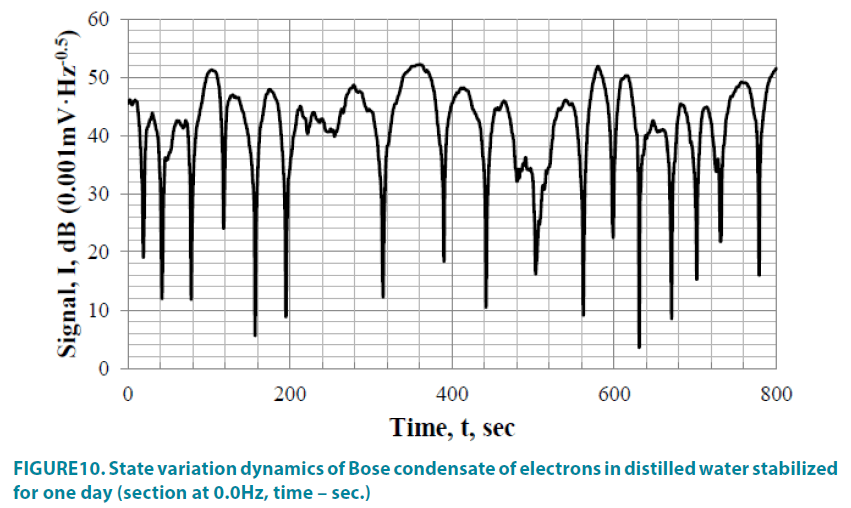Review Article - Clinical Practice (2018) Volume 15, Issue 5
Water as the main regulator of intracellular processes
Anatoly Stekhin1, Galina Yakovleva1, Konstantin Pronko2 and Vladimir Zemskov2*1Centre for Strategic Planning and Management of Medical and Biological Health Risks, Moscow, Russia
2Department of Research and Development at Facecontrol, Inc., Florida, Miami, USA
- Corresponding Author:
- Vladimir Zemskov
Department of Research and Development at Facecontrol Inc.
Florida, Miami, USA
E-mail: vzemskov@facecontrol.biz
Abstract
This paper addresses the investigation of water as the main regulator of intracellular processes. The research is based on assessing the impact associated water phase electromagnetic activity has on biological processes as well as determining its relationship to quantum states of delocalized electron system. The study demonstrates that the characteristics of electromagnetic emissions of water in SHF- and low-frequency (Hz–kHz) ranges are determined by dynamic states of superconductivity of associated water phase and are described within the framework of self-organization of hightemperature granulated superconductor with on-off intermittency. The paper describes the importance of obtained quantum laws in order to substantiate a regulatory role of associated water phase related to high organism sensitivity to electromagnetic emissions, and the detection of reasons for human diseases of metabolic etiology.
Keywords
associated water phase, electromagnetic emission, on/off – intermittency
Abbreviations
Phase of associated water, Electromagnetic radiation, On/Off - intermittency
Introduction
Human civilization has challenged science of biophysics and practical medicine giving rise to subversive tendencies in the overall health of planet's population and threatening human kind with degradation and extinction of Homo Sapiens as a species. What led to this dead end in science and healthcare, despite abundant financial and human resources dedicated to fighting these negative phenomena? Apparently, certain developments in biology and medicine have stumbled into differences with the fundamental truths of biological organism’s functioning.
The “western” understanding of human development sees it as a certain cyclical process of biochemical reactions, while the “eastern” view has at its core the idea of life energy, its existence, circulation and role in an organism. Despite the seeming difference, recent scientific achievements in biology reveal a common ground where these notions unite – water in an organism as the main component influenced by the external environment.
Biophysical studies of water conducted in previous years serve as evidence of the determinant role that associated water phase plays in regulation of biochemical processes in living organisms [1,2]. However, simply acknowledging this fact is not sufficient to objectively understand the biophysical processes of an organism responsible for further evolution of regulating action of the phase. Moreover, there is an entire list of unsolved fundamental problems in biology and medicine which require understanding in terms of internal processes regulation in an organism.
An example of such a problem is intracellular processes (for instance, catalytic activity and action specifics of enzyme proteins and cytokines, regulation of intracellular gene inclusion/ exclusion processes, cell differentiation and apoptosis mechanism), which can be solved by creating a harmonious ontogenesis theory that addresses the integration of differentiated tissues and organs into the entire organism, adequate aging theory [3] and others. Apparently, classical notions about water cannot hold an answer to these questions. Systematical consideration of water biophysics issues requires, besides integration of knowledge about water acquired in various scientific areas, a quantum approach in their analyzing and systematization.
One of problematic issues in biology and medicine, directly associated with study of water state change patterns when exposed to external factors, is experimentally detected high organism sensitivity to low-intensity electromagnetic and acoustic emissions [4,5]. According to [6], organism homeostasis is related to millimeter wave electromagnetic emission generated by cells. The main component of organismic water able to respond to external electromagnetic emission is the phase of associated water. It is the only collective structure that can claim to function as an electromagnetic emission receptor [7].
In this regard, the actual objective of this study is to examine the primary link of external signal reception in biological systems, which is responsible for occurrence of biological effects related to electromagnetic activity and generation of anion-radical forms of oxygen in water. As mentioned above, this primary link is water, or rather its associated phase. Its properties, many of which are beyond existing physical concepts, are responsible for progress of all metabolic processes in living organisms without exception.
Research Objectives
1. To determine time-related dynamics of superfluid behavior of electrons in associated water phase.
2. To establish the interrelation between very high frequency (VHF) electromagnetic emission of associated water phase and lowfrequency electromagnetic emission.
3. To prove the collective nature of electron behavior and generation of anion-radical forms of oxygen when exciting the phase instability of water associates.
An electromagnetically sensitive medium, the associated water phase has a form of unipolar chains structures of associates (FIGURE 1) oriented along the largest dimension of a vessel. For example, in a cylindrical vessel, the associate chains orientation matches the cylinder’s center pole; in a Petri dish, chains are distributed in an apron shape from dish center, in parallel with dish plane (FIGURE 1) [8]. Structural arrangement of the phase, its electrophysical state and emission properties (emission and absorption of hard radiation electrons and photons, electromagnetic wave emission) substantially depend on external factors, including the state of natural background of Bose condensate of electrons (delocalized state of electrons), electromagnetic and acoustic fields. Associated water phase, according to work [8], is a high-temperature superconductor. Superconductive (SC) state of associated water phase reflects the objective laws of its manifestation, first identified in the works of Bardin, Cooper and Schriffer (BCS theory) [9]. According to theoretical aspects of BCS theory, ionic lattice takes an active part in SC state. In water associates, ionic lattice is represented by tetragonal ice Wallrafen pentamers [10] with loosely coupled charges in nano-voids of lattice in form of ion radicals – ∈⊆-(*) and ⊆+(*). Electrons of ion radicals form a delocalized state by α-bonds of pentamers and take part in electron oscillations within the domains [1]. In associated states of water characterized by electron exchange interaction (…∈-— ⊆↔∈*— ⊆…), electron hole interactions proceed with formation of self-localized states [11]. Electron transition to superfluid state is associated with acquisition of electrons by oxygen atoms (…∈-—). Thus, they become magnetic and force magnetic moments of adjacent atoms to orientate accordingly [8]. Further development of physical understanding of charge states in dielectric media and water necessitates introducing quantum conceptualization of fractional regeneration of charges [12], which are the consequence of quantum delocalization of electron exposed to huge electric potential of two-dimensional phase interface achieving 108 V/cm [8,13].
The electron delocalization theory is based on the discovery of weak localization phenomenon [14] resulting from electron wave interference with formation of collectivized state, which maintains the shape of the interacting electron wave function. With that, electron is capable of participating interference with other electrons. We can say that mixing of de Broglie wave phases separates within the macroscopic sample the quantum-coherent mesoscopic areas, within which the interference determines the selfconsistency of the entire macro-object behavior and system boundaries are established. Inside the mesoscopic area, the sample behaves as a unanimous integrated quantum coherent system [15].
Main physical characteristics of mesoscopic systems are not self-averaging [16] and are capable of self-reproducing the initial structure of quantum oscillator. This is related to the simultaneously present strong changes in the interference pattern and a small change in the interacting with the system and generated by the “driving” oscillator external vector potential.
To excite a supercurrent φσ, classical superconductor must have a certain geometry (long cylinder parallel to external field), which allows generating, in working medium of superconductor exposed to superfluid motion of electrons, the cylindrical magnetic field shielding the external magnetic field (rot ⊆=4π· ⊆ js), where vector differential operator rot ⊆ C describes rotational component of magnetic field work ⊆ which generates a new vector field [17] capable of changing magnetic induction in the adjacent to superconductor area, especially in conditions of critical behavior of the supercurrent. Type 2 high-temperature superconductors are related to granulated superconductors. The behavior of the latter is viewed in context of low-intensity field electrodynamics of high- temperature superconductors [18].
Main provisions of low-intensity field electrodynamics are that, unlike conventional Josephson effect, unbalanced effect of granulated superconductor requires self- consistent dynamics of quasi-particles and Josephson phases when superconductors are contacting through thin dielectric layers [18,19]. As a result, the interaction of contacts has a substantial effect on VHF properties which, with external excitation exceeding critical current (at J > Jc), lead to voltage oscillation in transition with period of T = 2π/ωJ, where ωJ -"Josephson frequency", related to average voltage in transition Vav.
2e·Vav.= (h/2π) ωJ
Non-stationary effect is expressed by Josephson oscillation frequency fJ=ωJ/2π, relation between which and applied voltage is fJ/V ~ 500MHz/μV. At a typical for transition voltage V= 10-6:10-3 V, the oscillation shows up in high-frequency range (fJ = 109:1012 Hz).
Water as superconductor covers VHF oscillation at 1 GHz and in the range up to 155 GHz [20]. Therefore, Josephson oscillation of granulated superconductor, which associated water phase can be considered as, covers essential submillimeter frequency range. Experimentally observed excitatory SHF and EHF generation bands of water emission at 1 GHz and higher have a high quality factor (Q = 100–200). Generation bandwidth reduction results from synchronization of Josephson generation with SHF and EHF water self-field emission. The mutual synchronization and mutual phase locking in Josephson contact systems with high- frequency electromagnetic interaction have been a subject of numerous theoretical and experimental investigations.
Meanwhile, Josephson contact at nonzero voltage is a source of non-thermal quasi- particles, which stimulates unbalanced dynamics of a superconductor – populations of electron- like and hole-like branches of elementary excitations spectrum start to differ (electron-hole unbalance), which leads to change in chemical potential of superconducting condensate (number of superconducting electrons is changing to compensate for excessive charge of quasi-particles) and ingress of electric field into superconductor (see reviews [22,23]). Unbalanced amplification of Josephson oscillation is correlated with stochastic systems, where the fluctuation is a determinant factor of their dynamics [24].
However, SC-state of water, represented by chain structures of associates (FIGURE 2), has unique features in comparison not only with traditional superconductors, but with type 2 superconductors as well. Generating behavior of water characterized by various modes, depending on exciting field intensity [25], is a perfect example of non-linear unbalanced stochastic systems, which multiconnected granulated high-temperature superconductors are related to.
For similar superconductors, an absolutely new type of critical state is discovered - selforganized critical state, and systems showing In-off intermittency (blowout bifurcation, which can lead to an extreme form of intermittent bursting [26]), where a new phenomenon is discovered-super-sensitivity to weak variable signals. These self-synchronized self- oscillating systems showing chaotic dynamics are united not only by the substantial, or in case of In-off intermittency - determinant role of fluctuations, but by polynomial (scaling – 1/f ) dependencies of main probabilistic characteristics as well [27].
In accordance with existing concepts, granulated high-temperature superconductors (HTSC) are multiconnected Josephson media [28], current versus voltage curve of which is very anisotropic in space (i.e. not dependent on Lorentz force) in relation to angle between magnetic field and electric current. However, experiments demonstrated that, for granulated superconductors, vector matching of electric and magnetic fields and other excitatory emissions are not critical (longitudinal current problem [29]). These results became the basis for creation of a new concept in low-intensity field electrodynamics of HTSC (self-organization of critical state in granulated superconductors) [30].
In self-organized systems characterized by existence of significant number of metastable states, between which transitions take place, superconductor evolution process leads to critical state spontaneously, without any external adjustment. Polydomain dynamic systems accumulating small disturbances naturally evolve to a critical state, which is selfmaintained further, i.e. not requiring vector matching of external excitatory parameters for its existence. In terms of structure, critical states of superconductor are the set of many metastable states in which polydomain system is wandering. Small external impacts continue to bring the system out of one metastable critical state into another, and in the reconstruction process induce a dynamic process in the system (“avalanche” - quantum generation), upon completion of which the system is in a new metastable critical state. Avalanches may be both small and huge, covering the entire system, but they are generated by equally small disturbances. The system in its self- organized critical state loses its characteristic correlation length and time scale.
To observe avalanche dynamics in such unorganized systems, besides dynamic measurements, spectral density of fluctuation capacity (1/f type spectral density) may be used, which is formed as a result of summarizing contributions of various noise sources with wide distribution of characteristic times [31]. Noise sources of self-organized systems, including living organisms [32], are electromagnetic and acoustic excitations, phase transitions [33], targeted transport of substance and other processes [34,35].
Targets, instruments and methods of study
The study of collective electron dynamics of associated water phase was performed using bottled drinking water (Nestle trademark) and distilled water, both exposed to informational impact of broadband EHF-emission of semiconductor injection generator, as well as natural resonators - natural source of informational electric potential [20]. Selection of such heterogeneous objects for affecting water is determined by the required minimal exposure to technogenic emissions in process of discovering features of collective behavior of water associates.
Micropower EHF-emitter (power of electromagnetic emission is 10-16 W/cm2 to 10-18 W/cm2) operating in broad band from 40 GHz to 180 GHz [36], is a semiconductor injection generator with indium phosphide (InP) alloy layers. Generating layer of the emitter is between two grown n-type conductivity layers and p-type conductivity layer with contact plates on the opposite side.
Honey bees, precisely, electric charges carried by them, are used as natural excitatory media affecting the system. Value of charge carried by the bees varies from -0.45 to 80pC [37]. It is obvious that at such small charge values, intensity of field in adjacent to the beehive area (0.3 m to 1.5 m) may not exceed 1 μV/m (Coulomb's law).
Low power of emission (when using EHFemitter and coulombian charge) are incapable to affect the intensity of electric field, but they may be considered as informational sources of medium excitation.
In order to exclude electromagnetic interference during the study, water was exposed to dielectric polarizing structures. Pyramids made of dielectric material may be related to these structures, which make them a convenient tool for study of effect of polarizing natural structures and dynamics of production of active oxygen forms in water exposed to them.
A pyramid dielectric polarizing structure was chosen as a result of previous experiments with excitation of EHF-emission by water located in different points of the pyramid [20].
Concentration of peroxide anion-radicals in water was measured with high-sensitive kinetic chemiluminescence technique using luminolhaemin reagent (LIK device [38]). Instrumental implementation of kinetic chemiluminescence technique ensures capability or high- sensitive (about 10-2 μg/l) selective (separately from free radicals) measurement of fluctuations of concentration of anion-radicals in water [8].
Electromagnetic emission of water and aerosol atmosphere exposed to informational effect of generators was evaluated with EFA-300 device (USA).
In order to detect the features of dynamics of superfluid component of associated water phase in water samples, experimental model of a recorder of Bose condensate of ambient electrons (KM-detector) developed on the basis of reduction of wave Ψ-function of delocalized electrons was used [1,43].
For a detector, this system is using a finedispersed diamond-graphite mixture, which allows accumulating electrons in its extrinsic and own paramagnetic defects [39].
In such composite structures, active centers possess electron-acceptor and electron-donor properties providing n-type conductivity. In this process, electrons of active centers will transit from donor levels to conduction band with high probability, where their states will be delocalized and they can contribute to the electric current.
In a diamond structure, there are a few paramagnetic centers, such as C-center (as neutral single substituent atom of nitrogen), A-center (paramagnetic defect W24 - with a structure of pair of equivalent atoms of nitrogen in adjacent nodes of crystalline lattice [N-N]+ and formed during radiation caused by ionization of A-center [40]), negatively charged long-living center (NV- center [41]) and others [39], which can participate in a non-local electron transfer to conducting structures of graphite.
Operating principle of ⊇⊂-detector may be expressed as following processes: negatively charged NV- center of a diamond (NV- → NV0 transition) is involved into charge transfer filling ⊕ level, passing through singlet state to 3ℵ level with formation of neutral defect (NV0) and electron delocalization to conducting structures of graphite. Quantum electrodynamics of NV- centers in diamond nanocrystals is characterized by the fact that, after a number of consecutive electron excitation and emission cycles, NV- center maintains electron spin state (ms=0) withhigh probability (about 90%), i.e. medium polarization occurs [42], which provides inducing the currents in fine-dispersed diamond-graphite composition.
Therefore, diamond-graphite mixture provides sensitivity of a ⊇⊂-detector to Ψ- function of delocalized state of electrons in aqueous medium located in closest to the detector space (|Ψ⌡|2). Subsequent disintegration of singlet state of the center with delocalized electron and its re-condensation to conduction band of graphite (n-) is as follows:

To obtain maximum signal, the water sample is placed to the detector. Signals of normal electrons (after partial “collapse” of wave function in paramagnetic diamond-graphite mixture) are recorded by high-sensitivity analogdigital ZetLab system.
Effect of excitation with EHFemission and natural generators on low-frequency electromagnetic emission of water and aqueous aerosol
Main absorption and generation frequencies of water emissions are identified in EHF- band as doublets of 50.3 GHz and 51.8 Ghz, 64.5 GHz and 65.5 GHz, and their high frequency harmonics of 129.2 GHz and 131.4 GHz; 100.6 GHz and 103.6 GHz [20]. Low frequency harmonics of basic oscillation frequencies induced in electric and magnetic fields reflect, as per this work, the following frequencies:
- in magnetic field (⊆ = 4 mT/cm) - 25.1 GHz and 25. 9 GHz,
- in electric field (⊆ = 600 V/cm) - 32.2 GHz and 32.7 GHz
In addition, independent of the excitatory frequency, VHF-oscillation at the frequency greatly offset by exciting radiation occurs in the aqueous system (trans-resonant oscillation as per authors' terminology [20]). While it is in the same range (1 GHz), its intensity depends on the excitatory radiation intensity in the narrow range of power density (∠ μW/cm2) of incident EHF and SHF radio waves (stochastic ∠ ≥ 103, self-oscillating ∠ ≈ 103-101, stationary ∠ ≤ 101). Radiation of He-Ne laser at 0.63 μm wavelength also excites regeneration of trans-resonant SHF electromagnetic waves at 1 GHz in water and biological tissues with power transformation efficiency of ~10-5. Radiation at 1 GHz does not disappear after exposure to generators, but sustains for a long time, which served as a reason for the authors, who discovered this phenomenon, to name it SHF luminescence [20].
However, such time dynamics characterized by logarithmic and exponential dependence is typical for the superfluid state [26,27], which is, in our opinion, associated with effects of temporary non-locality of the exciting factor. It is obvious that the main energy source behind the long afterglow of water is not energy accumulated from water exposure to radiation, but a process of electron-phonon transformation realized by the exchange interaction between electrons with thermal oscillations of lattice.
Analyzing the temperature dependence of long-term radio emission intensity of water obtained in work [20], it should be noted that the maximum temperature reaches 35°∇ and matches the temperature of associates achieving their maximum size [8,42,43]. This allows establishing direct dependence of long-term radio emission with content of associated water phase in volumetric water [43].
The author of [20] notes that the lowintensity generation of “resonant” SHFemission at 1 GHz by water is its constant concomitant property observed when water is exposed not only to external physical fields, but also to background emissions, which allows considering natural electromagnetic emissions as emissions related to dynamics of quantum states of water. Maintaining longterm emission in aerosol atmosphere (Aitken nuclei [8]) at humidity exceeding 60% [20] provides conditions for automatic adjustment of electromagnetic activity of water, including its spectral and polarization states, to the environment and, vice versa, change of emission state of water in ambient under the influence of induced excitations reflects the state of metastable structures in water.
An important methodological feature of study of quantum properties of aqueous medium is coupling the water SHF-emission processes with its electromagnetic wave emissions in the lowfrequency band. To study the excitation of water electromagnetic emission, dielectric resonant structures were used (“mercab” bi-pyramid and 4-faced ordinary pyramid). TABLE 1 displays the emission properties of aerosol component in electromagnetic emission ranges with greatly diverged frequencies, showing unambiguous relation of radio emission density of aqueous aerosol in SHF-band with electric field intensity in the range of 5 Hz to 2 kHz.
| Location of sensor in relation to pyramid height | Bi-pyramid (height - 3m, material – bamboo) |
4-faced pyramid (material – copper) | ||
|---|---|---|---|---|
| Intensity of 5 Hz- 2 kHz field, (average) Е, V/m |
SKO Е, mV/m |
Conc. of НО2-(*), μg/l | Intensity of SHF- emission (1GHz), n·1015 W/V [20] | |
| Н=0m | 2.2 | 165 | 0.005 | 3 |
| 1/3 | 2.8 | 183.5 | 1.45 | 5 |
| 1/2 | 3.2 | 208.7 | 3.50 | 10 |
| 2/3 | 3.7 | 247.1 | 4.80 | 25 |
Table 1. Radio emission characteristics of aerosol component and induction of peroxide anionradicals in water exposed to active dielectric structures (pyramids).
As follows from the results, most active area of pyramids is 2/3 of their height. Increase of wave activity in 1 GHz range is accompanied by a synchronous increase of field intensity in the low frequency wavelength range. In addition, under the effect of bi-pyramid, peroxide anionradicals are produced.
Frequencies of generating pulses of the bipyramid electromagnetic emission (TABLE 2) correspond to the reduction of their intensity as the generation frequency is increased. An exception is 8 Hz frequency displaying strong variations. Such variations reflect the 1/f dependence of generating pulses intensity of electric tension specific to granulated superconductors.
| Frequency, f (Hz) | 01-Apr | 8.0±0.1 | 12.1±0.3 | 16.0±0.1 | 20.3±0.1 | 24.6±0.6 | 39.8±2 | 4±8 |
| Intensity, Е (mV/m) | >2 | 132.1±27 | 158.9±7 | 81.01±6 | 89.5±13 | 98.9±5 | 76.4±9 | 1±13 |
| V/m |
Table 2. Frequencies and intensities of generating electromagnetic pulses of mercab bipyramid.
To evaluate the effect of EHF-emission on generation of low-frequency emission (in 5 Hz to 2 kHz range) in water, Nestle water (factory-packaged) was studied in laboratory conditions (basement with minimum power line disturbances). Electromagnetic emission in aqueous medium was measured with the EFA- 300 device. Water was treated for 5 minutes with an EHF- emitter located on the side of the water vessel. The broadband water emission signal was recorded in two modes: rms – rootmean- square value, and peak – peak value in sampling interval with 1sec variation period.
The dynamics of low-frequency emission of water, represented in FIGURE 3, reveal the excitation of water emission of higher pulse amplitudes in comparison with the initial (before exposure to radiation) sample state. This confirms implementation of periodically excited dynamic processes which sustain for a long time, and past the sample exposure to EHF-emission.
Figure 3: Variation of low-frequency emission (minus contribution of 50 Hz - 1.5 V/m) of Nestle water (0.5l polymer bottle) after 5 minutes exposure to EHF-emission of semiconductor generator (emitter on the side, adjacent to water bottle, recorder – an alternating electric field intensity measuring instrument EFA-300, frequency range – 5 Hz to 2 kHz, detector – peak).
Statistical characteristics of low-frequency electromagnetic emission in 5 Hz to 2 kHz range are presented in TABLE 3. Their analysis suggests that water treatment with EHF-emitter causes increase of low-frequency emission, which is in agreement with the data on aerosol atmosphere exposed to polarization by dielectric structures (TABLE 3). Statistical parameters of variations of low-frequency electromagnetic emission of water excited by EHF-emission of semiconductor generator confirm the increasing emission in water and of the long-term conservation of its variational parameters.
| Parameter | Initial (w/o EHF) | EHF | after EHF |
| Intensity, ⊕, V/m (average) | 1.13 | 1.20 | 1.24 |
| Variations, rel. un. | 0.114 | 0.225 | 0.117 |
| SKO, V/m | 0.130 | 0.270 | 0.145 |
Table 3. Statistical characteristics of low-frequency electromagnetic Emission in 5 Hz to 2 kHz range in Nestle water (0.5l polymer bottle) after 5 minutes exposure to EHF-emission of semiconductor generator.
Emission lines of quantum generation of water (LF (low frequency) emission) are characterized by occurrence of short-term highamplitude values of normal component of generating field of water (FIGURE 4). These signals are equalized by averaging the values of emission intensity signal, which allows detecting time-like structures of the signal acquired during exposure to radiation and sustaining for a long time. Time-like structures reflect the property of quantum non-locality of macroscopic quantum excitation of superconductor and manifest themselves not only in the future, but in the past as well. This may be explained from a perspective of transaction interpretation of quantum mechanics [44] as type 2 non-locality effect.
Figure 4: Variation of low-frequency emission (minus contribution of 50 Hz -1.3 V/m) of Nestle water (0.5l polymer bottle) after 5 minutes exposure to EHF emission of 1 μW Vodoley device (emitter on the side, adjacent to water vessel, recorder – alternating electric field intensity measuring instrument EFA-300, frequency range – 5 Hz to 2 kHz, detector - rms).
FIGURE 5 (top and bottom) displays outlines of emission lines in gigahertz wavelength range (FIGURE 5-top) and the envelop curve of density distribution function of low-frequency electromagnetic emission (FIGURE 5- bottom). Pursuant to the graphs, these outlines are characterized by the same Gaussian curve, which leads to suggesting a single source of emission origination mechanism determined by processes of parametric transformation of highfrequency emission to low-frequency emission. Therefore, origination of EHF-emission lines may not be determined by molecular oscillators, re-emission of which simultaneously forms the complete set of spectral lines rather than separate generation frequencies [45].
Figure 5: EHF-emission of distilled water with excitation in 50.3 GHz and 51.8 Ghz line range (according to the data from paper [20] - top) and statistical distribution of density distribution function of low-frequency emission by Nestle water with excitation by EHF-emission of semicon- ductor injection generator with maximum density of 74 Hz – bottom.
Objective laws of exciting long-term electromagnetic emission of water and aerosol atmosphere in broad frequency range determined by quantum behavior of associated water phase noted above, are not limited to proximal zone of its manifestation. Similar objective laws are caused both by quantum non-locality effects and induced self-organization.
A field study was performed in order to detect dynamic variations of electrical component of aqueous medium related to non-stationary behavior of Ψ-function of delocalized condition of water electrons. Dependence of electric field intensity excited in aerosol component of atmosphere (relative humidity 86%, temperature - 24°∇), displayed in FIGURE 6, shows existence of non-stationary states of Bose condensate of electrons in association phase of aqueous aerosols in form of aerosol crystals [8]). This reveals the more intensive manifestations of excited states in dynamics of superconducting state of aqueous component of aerosols when excited by a static electric charge, confirmed by the theory of non-linear unbalanced stochastic systems [25].
A perfect example of non-linear unbalanced stochastic system is the effect of point static charge as it is introduced to an aqueous aerosol system. For example, electric field intensity value in aqueous aerosol system, with exposure to point static charge introduced by a bee, reaches a few hundreds of V/m. Succession periods of “thickening” of field intensity pulses are related to intensity of bee arrivals to the hive (FIGURE 6). Therefore, abnormal electromagnetic activity in aqueous aerosols is a consequence of development of non-linear dynamics of superconducting state of water.
According to the graph, absolute values of electric field intensity of aqueous aerosol in 5 Hz to 2 kHz range caused by bees is exceeding peak values obtained by informational (EHF) excitation of water associates by a factor of 100 (FIGURE 3). This means that, in process of development of water associate instabilities, thermodynamic parameters are expressed more in aqueous aerosol, than in liquid [8,43]. However, the mechanism of their origination is identical and related to informational influence of filed potentials on water associates which are capable of transmitting excitation by chain structures and accumulate ambient energy, both by electron- phonon interactions and as a result of quantum condensation of excess electrons [8].
An example of collective process development followed by phase instability is the generation of electromagnetic emission in the system of conjugated aqueous aerosol particles in an aerosol crystal may serve as an example of development of collective process accompanied by phase instability (FIGURE 7). This proves that aqueous aerosols, as well as associates in liquid, are capable of forming ordered chain structures bound together by magneto-dipole interaction forces.
Figure 7: Collective process of phase instability development in aqueous aerosols
А. Emission and self-absorption of electromagnetic emissions in decomposition (phase transformation) of a single aerosol particle.
B. Phase instability of aqueous aerosol particle developing according to the system of conjugated aerosol parti- cles of aerosol crystal [46] into electron avalanche
Resonant oscillating excitations of aqueous aerosols induced by informational effect of point electric charge contribute to reduction of particle decomposition threshold in unstable condition (critical size), which allows involving entire aggregate of coherently oscillating particles into a collective process of phase transformation of associates.
Therefore, electromagnetic emission of water in low-frequency and high-frequency wavelength range is a single physical process determined by dynamics of superconducting state of electrons in associated water phase and parametric transformation of high-frequency signals into low-frequency signals. A feature distinguishing aqueous medium associate behavior from granulated high-temperature superconductors in post-critical state of superconductive phase is the formation of crystallizational-deformationalthermal instability within accompanied by decomposition of the amorphous structure of associated water phase.
Dynamics of superfluid component of electrons in associated water phase
In order to record dynamics of superfluid electron component in aqueous medium, the quantum mechanical (QM) sensor was used, which allows non-local recording of superconductive electrons in water via partial “collapse” of wave function in paramagnetic centers of structure defects of diamond-graphite composition.
In order to reduce sensor sensitivity to background electromagnetic emission, it was shielded with conductive material (1 layer of metal foil) providing reduction of electromagnetic emission (EME) signal by 45 dB (with I50Hz w/o shield = 92.5 dB, I50Hz w/shield = 45.8 dB). With the shielding the QM-sensor signal, determined by occurrence of superfluid component of electrons from water sample, was reduced by 5 dB only, which is by an order lower in comparison with the signal reduction from the electromagnetic emission component (FIGURE 8). Therefore, sensor shielding ensures a reliable registering of superfluid component of electrons from water samples against the background of interference emissions.
Destabilizing effect on water (transition of water sample) is expressed in a variation of the detector signal time structure. For example, within time intervals before and after short disturbances of water in the bottle (transition), recorded signal takes stochastic form with time (in 1 hour), which exists for 2 hours with subsequent establishment of quasi-periodic mode of signal variations (FIGURE 9, time – 15:29). It is obvious that formation of stochastic fluctuations in time is related to interference of leading and lagging wave functions of delocalized electrons.
In conditions of water stability, quasi-periodic mode is set in the system (slow time evolution of signal intensity with periodic collapses). Such dynamics of superconductive state of water demonstrates the behavior of a SC system with on-off intermittency manifesting itself by the fact that relatively smooth current changes are subject to interruption of superconductive state in aqueous medium (FIGURE 10). Incoming excitations from ambient (at 250–400 seconds) manifest as the distortion of smooth signal evolution. Consecution density of “collapses” of Ψ- function is related to entropy factors.
The dynamics observed in superfluid component in aqueous medium reflects phase behavior of long Josephson transitions system with inductive and capacitive coupling. Such behavior generates longitudinal plasma wave (interfering in dielectric polarizing structures) and parametric resonance of concomitant electromagnetic emissions. Simultaneously with longitudinal plasma wave, flux quantum states of superconductor occur in the system. This indicates formation of new collective excitation in the system of coupled Josephson transitions in composite state of Josephson current, electric field and vortex magnetic field [46,47].
Therefore, the uniform physical nature of electromagnetic emissions generation in SHF range and low-frequency range is determined by dynamic states of superconductive phase of associated water described within framework of self-organization of high-temperature superconductor with on-off intermittency.
Consequently, water as a superconductive system with self-organizing supercritical state possesses super sensitivity to weak variable signals, thus hosting a possibility for exciting supercurrent in a biological system by means of external electric or electromagnetic disturbance.
These disturbances of aqueous medium are accompanied by non-linear dynamics of supercurrent occurrence in water as well as an emerging excitation of electron subsystem of associated water phase, of informational nature, which is transmitted over chain structures of associates to active centers of the organism. Associates possess properties of self-supporting and self-reproduction of their state due to the processes of exchange with ambient. The excitation of non-stationary SHF and LF emissions of water is characterized by non-local behavior in time determined both by leading and lagging states of electron component in associated water phase.
Importance for Biology and Medicine
Physical notions of superfluid state of associated water phase electron subsystem open a way for new considerations and attitudes to the many problems in biology and medicine, including scientific basics of organism ontogenesis and applied solutions to problems related to diseases of metabolic etiology. Considering the regulatory and transport functions [1,8], as well as conformation processes implemented by means of electron subsystem of associated water phase along with electron transition specifics in its structures, diseases of metabolic etiology may be defined as processes related to degradation of associated water phase. For example, in cellular membranes, phase degradation causes not only deficiency of electrons entering the cell but leads to a change in physical condition of electron conjugation channels, disturbance of processes of electron exchange with ambient, all of which contribute to the organism aging problems.
Excitation of collective quantum states in associated water phase is reflected in keto-enol tautomerism of compounds in cellular structures, periodical conformational transformations in proteins and changes in enzyme activity. Peroxide anion-radicals, formed during the process of phase instability development, function in a living cell as a macroscopic quantum regulator of metabolic processes and determine not only rhythm-generating functions, but shapegenerating functions as well.
Change in quantum state of associated water phase under effect of external emissions is not only the reason for blocking or stimulating cellular structures of organism, but for their functional change as well. For example, in a normal condition of organism, associated water phase possesses double emission spectra at 985 MHz and 1000 MHz frequencies. If oncology diseases are present, emission bands are combined with maximum emission at 990 MHz [20]. Such changes in frequency characteristics of electromagnetic emission are related to change in structural and energetic state of water associates determined by degradation of electronic state of associated water phase and, accordingly, reduction of its charge state [48]. As such, quantum processes of self-organization of electron subsystem of water associates, responsible for manifestation of sensitivity of regulatory intra- and intercellular mechanisms to exogenous effects and changes in electrophysical (ion-radical) state of inter- cellular and intra-cellular medium (water) indicate that water is the main regulator of intracellular processes, and changes in its electron state in organism may cause the emergence of non- infectious somatic diseases of metabolic etiology.
References
- Rakhmanin YA, Stekhin AA, Yakovleva GV. Biophysics of water: Quantum non-locality in water treatment technology; regulating role of associated water in cellular metabolism; rating of bioenergetic activity of drinking water. Moscow. Lenand. 353 (2016).
- Stekhin A, Yakovleva G, Pronko K, Zemskov V. Quantum biophysics of water. Clin. Pract. 15(3), 579-586 (2018).
- Gems D, Partridge L. Genetics of longevity in model organisms: debates and paradigm shifts. Annual review of physiology. 75, 621-644 (2013).
- Darovskikh SN. Informational physiotherapy and instruments for its implementation. News of South-East State University, Series: management, computer facilities, informatics. Medical instrument engineering. 1, 60-66 (2011).
- Pickard WF, Pickard EG. Energy deposition processes in biological tissue: Nonthermal biohazards seem unlikely in the ultra-high frequency range. Bioelectromagnetics. 22(2), 97-105 (2001).
- Deviatkov ND. Discovery of normalization effect of functional condition of human internals exposed to water activated by millimeter emission. Millimeter waves in biology and medicine. 8, 65-68 (1996).
- Waterson DG. Role of water in cell functioning. Biophysics. 36(1), 5-30 (1991).
- Rakhmanin YA, Kondratov VK, Mikhailova RI.. Water as cosmic phenomenon: cooperative properties and biological activity (second edition, revised and amended). Karlovy Vary, CZ. 457 (2014).
- Shmidt VV. Introduction to superconductor physics. М. МCNMO. Russia (2000).
- Walrafen GF. Roman spectral studies of water structure. J Chem.Phys. 40, 3249-3256 (1964).
- Brandt NB, Kulbachinski VA. Quasi-Particles in physics of condensed state. М. Fizmatlit. Russia (2005).
- Bykov VP. Fraction charge- new trend in electronics. UFN. 176(9), 1007-1014 (2006).
- Girvin S. Quantum Hall effect: unusual and disturbed symmetries. Moscow-Izhevsk Computer Research Institute. Russia (2003).
- Abrahams Е, Anderson PW, Licciardello DС, Ramakrishnan ТV. Scaling Theory of Localization: Absence of Quantum Diffusion in Two Dimensions. Phys. Rev. Lett. 42, 673 (1979).
- Moskalets MV. Basics of mesoscopic physics. Kharkov. NTU HPI (2010).
- Lee PA, Stone AD. Universal Conductance Fluctuations in Metals. Phys. Rev. Lett. 55, 1622 (1985).
- Naymark MA. Linear differential operators (2nd ed.). М. Nauka. Russia (1969).
- Josephson BD. Possible new effects in superconductive tunneling. Phys. Lett. 1(7), 251-253 (1962).
- Ryndyk DA. SHF properties of unbalanced Josephson contacts in submicron and laminated superconductors. Radioelectronics Magazine. 1 (2000).
- Petrosian VI. Radiophysics of water and life. Water, paradoxes and grandeur of small values. Saarbrücken: Lambert Academic Publishing. 494 (2017).
- Jain AK, Likharev KK, Lukens JE, Sauvageau JE. Phys. Rep. 109(6), 309-426 (1984).
- Nonequilibrium Superconductivity, ed. DN. Langenberg and AI. Larkin, Modern Problems in Condensed Matter Sciences North-Holland, Amsterdam.12 (1986).
- Gulian AM, Zharkov GF Superconductors in external fields. М. Nauka. Russia (1990).
- Belkin MA, Capasso F, Xie F, et al. Room temperature terahertz quantum cascade laser source based on intracavity difference-frequency generation. Appl. Phy.s Lett. 92(20), 201101 (2008).
- Gurovskaya MK. Behavior features of some non-linear systems adjacent to border of chaotic phase synchronization mode: destruction / establishment of synchronous mode, intermittency. Thesis. Saratov. Russia (2009).
- Bashkirtseva I, Ryashko L. Stochastic sensitivity analysis of noise-induced intermittency and transition to chaosinone-dimensional discrete-time systems. Physica A. 392(2), 295-306 (2013).
- Gerashenko OV. Study of non-linear stochastic systems: Granulated superconductors and systems with on-of intermittency. Thesis. Russia (2000).
- Barone A, Paterno J. Josephson effect. М. Mir (1984).
- Ryndyk DA. Nonequilibrium Josephson effect within the systems of tunnel superconductor contacts and in laminated superconductors. ZhETF. 89(5), 975-985 (1999).
- Savitskaya NE. Avalanche dynamics of magnetic flux and self-organization of critical state in discrete superconductors. Thesis. Gatchina Russia (2007).
- Ginzburg SL, Pustovoit MA, Savitskaya NE. Interavalanche correlations in self-organized critical state of multijunction SQUID. Phys. Rev. E. 57(2), 1319-1326 (1998).
- Sitnikova E, Hramov AE, Grubov VV. On–off intermittency of thalamo-cortical oscillations in the electroencephalogram of rats with genetic predisposition to absence epilepsy. Вrain Research. 1436, 147-156 (2012).
- Li ZQ Huang. Transport of particles caused by correlation between additive and multiplicative noise. Phys. Rev. E. 57(4), 3917-3922 (1998).
- Castiglione P, Crisanti A, Mazzino A, et al. Resonant enhanced diffusion in time-dependent flow. J. Phys. A. 31(35), 71977210 (1998).
- Bashkirtseva I, Ryashko L. Stochastic sensitivity of noise-induced intermittency and transition to chaos in one-dimensional discrete-time systems. Physica A. 392(2), 295-306 (2013).
- RF patent No.134365 dd. 16.04.2012. Semiconductor injection generator based on А3В5 heterostructure.
- Eskov EK. Behavior of honey bees. Moscow. Kolos. Russia (1981).
- Ishutin VA, Karzanov VG. Peroxide compound detection technique.
- Komarovskikh AY. Study of structure and electron state of paramagnetic centers in diamond related with introduction of phosphorus, oxygen, hydrogen, silicon and germanium. Thesis Novosibirsk Russia. (2016).
- Tucker OD, Newton ME, Baker JM. EPR and 14N electron-nuclear double-resonance measurements on the ionized nearest-neighbor dinitrogen center in diamond. Phys. Rev. B. 50(21), 15586-15596 (1994).
- Loubser JHN, van Wyk JA. Electron spin resonance in the study of diamond. Rep. Prog. Phys. 41(8), 1201-1248 (1978).
- Tsukanov AV. NV-centers in diamond. Part II: spectroscopy, measurements, quantum operations. Microelectronics. 41(3), 163-180 (2012).
- Stekhin AA, Yakovleva GV. Structurized water: Non-linear effects. М. LKI. 315 Russia (2008).
- https://arxiv.org/abs/1503.00039
- Cernike F, Midwinter J. Applied nonlinear optics. М. Mir. 264 Russia (1976).
- Nefedov AP, Petrov OF, Fortov VE. Crystalline structures in plasma with strong interaction of particles. Success of physics. 167(11), 1215-1226 (1997).
- Rakhmonov IR, Shukrinov YM, Irie A. Parametric resonance in system of long Josephson transitions. Letters to ZhETF. 99(11), 735-742 (2014).
- Alexeev SG, Brandt NB, Mironova GA, et al. Method of diagnosis of oncology diseases and device for implementation. RF (1999).
